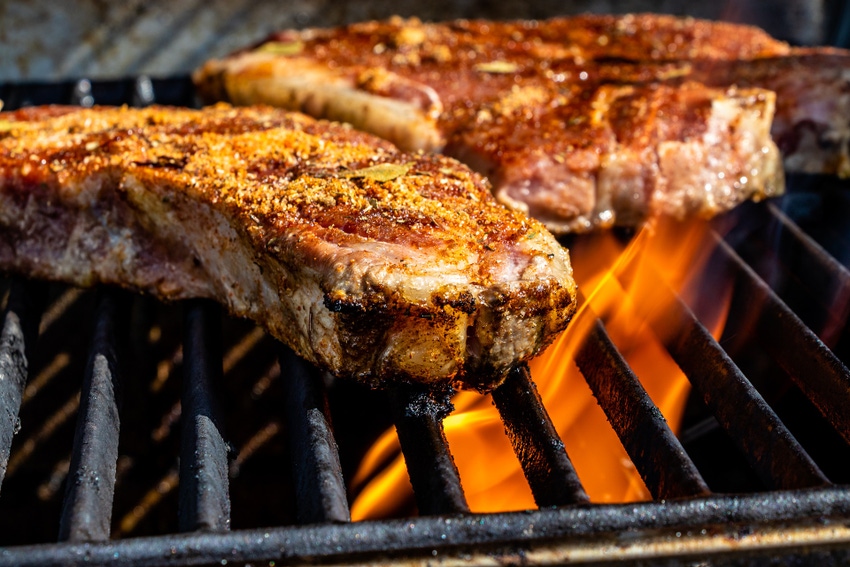Meat production improving, but labor availability still an issue throughout industry.

Memorial Day signals the traditional start of the summer grilling season, with meat and poultry promotions typically dominating the front page of grocery circulars around the country. This year, however, 210 Analytics LLC president Ann-Marie Roerink reported that a tight supply, along with price inflation and continued social distancing measures, created a very different marketplace and demand.
“Purchase limits remained in place for many popular cuts, all the while more states allowed restaurants to reopen dine-in facilities, altering the demand landscape yet again,” she said.
Despite the supply pressure, dollar sales still grew 20.7% the week of May 24 versus the same period last year, and volume grew 5.1%.
Year to date through May 24, Roerink reported that meat department dollar sales were up 24.7%, boasting double-digit growth for 11 weeks running. This, she said, reflects an additional $5.8 billion sold versus the same time period in 2019. Year-to-date volume sales through May 24 were up 17.3% over the same period in 2019, reflecting an additional 1.2 billion lb. of meat and poultry sold versus the same time period in 2019.
New data suggest that supply pressure appears to be lessening due to the supply issues improving and demand from retail softening a bit, Roerink added.
Christine McCracken, executive director of food and agribusiness at Rabobank, noted that U.S. beef production was only 8% behind year-ago levels during the holiday-shortened week, while pork production was 6% behind last year’s pace.
This is a significant improvement from late-April reports when beef and pork were at historically low levels, down 35% each, Roerink noted.
However, McCracken said labor availability remains a challenge throughout the industry, forcing some plants to forgo deboning and other value-added activity.
“The chicken industry faced limited disruption this past week with ample labor and plants able to run on Saturdays to maintain production volumes. Chicken supplies will soon tighten, however, as production cuts in April and May will begin to limit availability,” she said.
Regarding food retail and foodservice demand, McCracken said, “Retail interest following the Memorial Day holiday is softer for many items, with some buyers taking a more cautious approach, given uncertain consumer interest.”
Notably, there was some consumer pushback to higher prices on the shelf and limited ad activity for beef and pork, she said.
Foodservice demand also slowed, with pipelines now replenished and consumer demand still slow, although demand for tenders and wings was steady, while interest in ground product was also good.
Roerink said consumer comments from the Retail Feedback Group Constant Customer Feedback system showed that purchase restrictions and limited inventory continued to affect purchases during the week of May 24.
Consumers have also expressed frustration over higher retail prices that have resulted from the recent supply chain issues.
“Your prices are way too high on meat products,” one shopper said. Another said, “The price of meat is terrible. We see on the national news that farmers are being paid less for their beef, yet the prices in the store have gone up.”
Roerink said retailers are making adjustments in their ads to provide alternate options based on supply and pricing.
Samer Rahman, senior director of meat and seafood for Allegiance Retail Services, said, “For the first time in my over 30-year career, we did not feature top round London broil on the front page of our ads leading up to Memorial Day as a result of the current situation. We were forced to promote alternative items such as frozen pork baby back ribs, frozen chicken breast and frozen burgers. As a result, frozen meat sales have seen double-digit growth in the last few weeks.”
Market recap
August live cattle futures were mixed this week. Contracts closed lower Monday at $98.975/cwt. and saw large losses on Wednesday before closing higher Thursday at $97.925/cwt.
August feeder cattle futures closed higher Monday at $136.125/cwt., but losses ensued Tuesday, some of which were recovered Wednesday and again Thursday, when contracts closed at $134.725/cwt.
The Choice and Select beef cutouts closed lower at $272.76/cwt. and $260.41/cwt., respectively.
July lean hog futures contracts were mostly lower this week. Contracts closed lower Monday at $55.15/cwt. and Wednesday at $53.475/cwt. but posted gains Thursday to close at $53.575/cwt.
The pork cutout was mixed this week. The wholesale pork cutout closed lower at $74.85/cwt. Loins have retreated and were lower at $95.49/cwt. Hams and bellies were higher at $57.18/cwt. and $98.43/cwt., respectively.
Hogs delivered to the western Corn Belt were lower than the week before, closing at $34.44/cwt. on Thursday.
The U.S. Department of Agriculture reported the Eastern Region whole broiler/fryer weighted average price at 71.42 cents/lb. on May 29.
According to USDA, egg prices were steady, with a steady to mostly lower undertone. Supplies ranged from light to heavy. Offerings were moderate to available. Demand was light to moderate.
Large eggs delivered to the Northeast were unchanged at 82-86 cents/doz. Prices in the Southeast and Midwest were unchanged at 86-89/doz. and 74-77 cents/doz., respectively. Large eggs delivered to California were $1.49/doz.
For turkeys, USDA said the market was steady to firm, and demand was light to moderate. The price range for hens and toms was slightly higher at $1.03-1.08/lb.
About the Author(s)
You May Also Like



.png?width=300&auto=webp&quality=80&disable=upscale)

